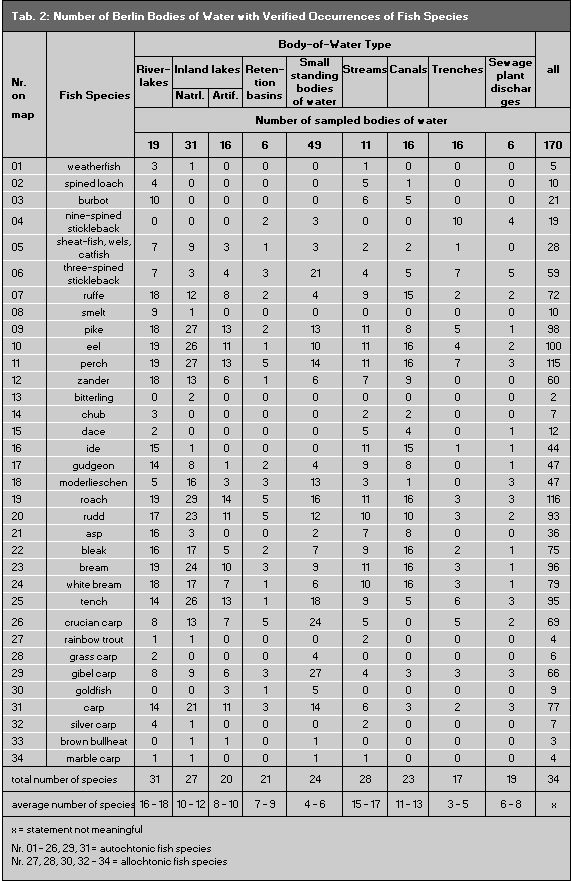During the recording period of 1993-2002, 34 species of fish were verified in the state of Berlin, including six non-local species. Compared with 1993, the species inventory was expanded by one non-indigenous fish species, the marble carp, a cyprinide originating in China, which was stocked, particularly during the 1980s, for economic reasons. Moreover, a second bullhead species has now been verified in Berlin, the black bullhead (Ameiurus melas). This species was already described by Doering & Ludwig (1992) for the bodies of water in the Great Tiergarten; however, it could not be taken into account in the current map representation either, since the living catch reports do not distinguish between the two species, so that their occurrences cannot be delimited clearly from one another (Wolter et al. 2003).
Since 1993, order has brought to the taxonomic chaos previously prevailing in the systematics of European freshwater fish, particularly due to the basic work of Kottelat (1997). As a result, the scientific species names of several fish species have been changed, by comparison with the last edition of the map. Besides this editorial change, the view of a species as not local (non-indigenous, neozoans) has been fundamentally changed. As the result of an international working group on Neozoans/ Neophytes, the year 1492, the official discovery of the "New World" by Columbus, has been established as the threshold year for the determination of a species as non-indigenous, since after this, the exchange processes of goods, commodities and also biota increased immensely between the continents. Species of fish naturalized after 1492 are regarded as non-indigenous, not local (Kinzelbach 1996, Kowarik 2003).
In glaring contradiction to this, the new Berlin State Fishing Regulation (LFischO, GVbl Berlin 57, No. 54 of December 22nd 2001) has, for purposes of simplification of economic stocking measures of the fish industry (abolition of approval requirements), established all species of fish naturalized since 1900 as local. However, this administrative simplification of stocking regulations is of marginal importance for the ichtheofauna, since the neozoans in terms of the stricter definition which still remain in Berlin waters are economically insignificant and hence, despite unrestricted stocking possibilities, in permanent decline (cf. Tab. 1 ).
The species carp and gibel carp, which are economically significant in Berlin, particularly for fishermen, are no longer viewed as non-indigenous, as they were in the edition 1993, since they demonstrably settled the Elbe watershed area, including the Havel and Spree, between 530 and 1100 (Hoffmann 1994).

